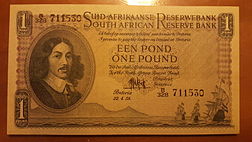
Back Suid-Afrikaanse pond Afrikaans Südafrikanisches Pfund German Libra sudafricana Spanish پوند آفریقای جنوبی Persian Etelä-Afrikan punta Finnish Livre sud-africaine French Fam na Afirka ta Kudu Hausa South Africa pound IG Sterlina sudafricana Italian 南アフリカ・ポンド Japanese
| Suid-Afrikaanse pond (Afrikaans) | |
|---|---|
 £1 note from 1958 | |
| Unit | |
| Plural | pond (Afrikaans) |
| Symbol | £ |
| Denominations | |
| Subunit | |
| 1⁄20 | shilling (sjieling) |
| 1⁄240 | penny (pennie) |
| Plural | |
| penny (pennie) | pence (English) |
| Symbol | |
| shilling (sjieling) | s or /– |
| penny (pennie) | d |
| Banknotes | 10/–, £1, £5, £10, and £100 |
| Coins | |
| Freq. used | 1⁄4d, 1⁄2d, 1d, 3d, 6d, 1/–, 2/–, 2/6 |
| Rarely used | 5/– |
| Demographics | |
| User(s) | Goshen |
| Issuance | |
| Central bank | South African Reserve Bank |
| Website | www |
| This infobox shows the latest status before this currency was rendered obsolete. | |
The pound (Afrikaans: pond; symbol £, £SA[1] for distinction) was the currency of the Union of South Africa from the formation of the country as a British Dominion in 1910. It was replaced by the rand in 1961 when South Africa decimalised.
In 1825, an imperial order-in-council made sterling coinage legal tender in all the British colonies. At that time, the only British colony in Southern Africa was the Cape Colony. As time went on, sterling and its associated coinage became the currency of every British territory in Southern Africa. At that time sterling followed the Carolingian monetary system of a pound divided into 20 shillings, each of 12 pence.
- ^ "Chapter 4: German-South African Experiencer under Special Exchange Agreements". Foreign-Trade and Exchange Controls in Germany. Washington D.C.: U.S. Government Printing Office. 1942. p. 242.